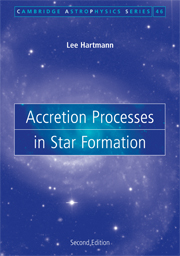Book contents
- Frontmatter
- Contents
- Preface to the first edition
- Preface to the second edition
- Acknowledgments
- 1 Overview
- 2 Beginnings: molecular clouds
- 3 Initial conditions for protostellar collapse
- 4 Protostellar cloud collapse
- 5 Protostellar collapse: observations vs. theory
- 6 Binaries, clusters, and the IMF
- 7 Disk accretion
- 8 The disks of pre-main-sequence stars
- 9 The FU Orionis objects
- 10 Disk winds, jets, and magnetospheric accretion
- 11 Disk accretion and early stellar evolution
- 12 Disk evolution and planet formation
- Appendix 1 Basic hydrodynamic and MHD equations
- Appendix 2 Jeans masses and fragmentation
- Appendix 3 Basic radiative transfer
- List of symbols
- Bibliography
- Index
7 - Disk accretion
Published online by Cambridge University Press: 30 October 2009
- Frontmatter
- Contents
- Preface to the first edition
- Preface to the second edition
- Acknowledgments
- 1 Overview
- 2 Beginnings: molecular clouds
- 3 Initial conditions for protostellar collapse
- 4 Protostellar cloud collapse
- 5 Protostellar collapse: observations vs. theory
- 6 Binaries, clusters, and the IMF
- 7 Disk accretion
- 8 The disks of pre-main-sequence stars
- 9 The FU Orionis objects
- 10 Disk winds, jets, and magnetospheric accretion
- 11 Disk accretion and early stellar evolution
- 12 Disk evolution and planet formation
- Appendix 1 Basic hydrodynamic and MHD equations
- Appendix 2 Jeans masses and fragmentation
- Appendix 3 Basic radiative transfer
- List of symbols
- Bibliography
- Index
Summary
As described in Chapters 4 and 5, the collapse of protostellar clouds with plausible amounts of angular momentum generally should result in the formation of disks as well as protostars. Disk formation during the collapse phase is then followed by a longer phase of disk accretion during which angular momentum is transferred to a small fraction of disk particles at large radial distances, permitting the accretion of most of the disk mass onto the central star (with some fraction possibly forming planets). The subsequent evolution of a star-disk system will be controlled by the rate at which angular momentum is transported in the disk.
Substantial progress has been made in understanding two likely mechanisms for angular momentum transport: magnetic turbulence and gravitational instability. Unfortunately, it has proved difficult to apply these mechanisms to the development of a predictive theory of disk evolution for young systems. The low ionization levels predicted for large regions of YSO disks make it unclear whether the magnetic field can couple sufficiently well to the gas for the so-called “magnetorotational instability” (MRI) to efficiently transport angular momentum. While it seems likely that the MRI operates in some regions of YSO disks, it is far from clear that it is the dominant factor in producing accretion. The effects of gravitational instability depend sensitively on disk energy balance, and local heating and cooling rates are difficult to determine.
- Type
- Chapter
- Information
- Accretion Processes in Star Formation , pp. 129 - 157Publisher: Cambridge University PressPrint publication year: 2008

